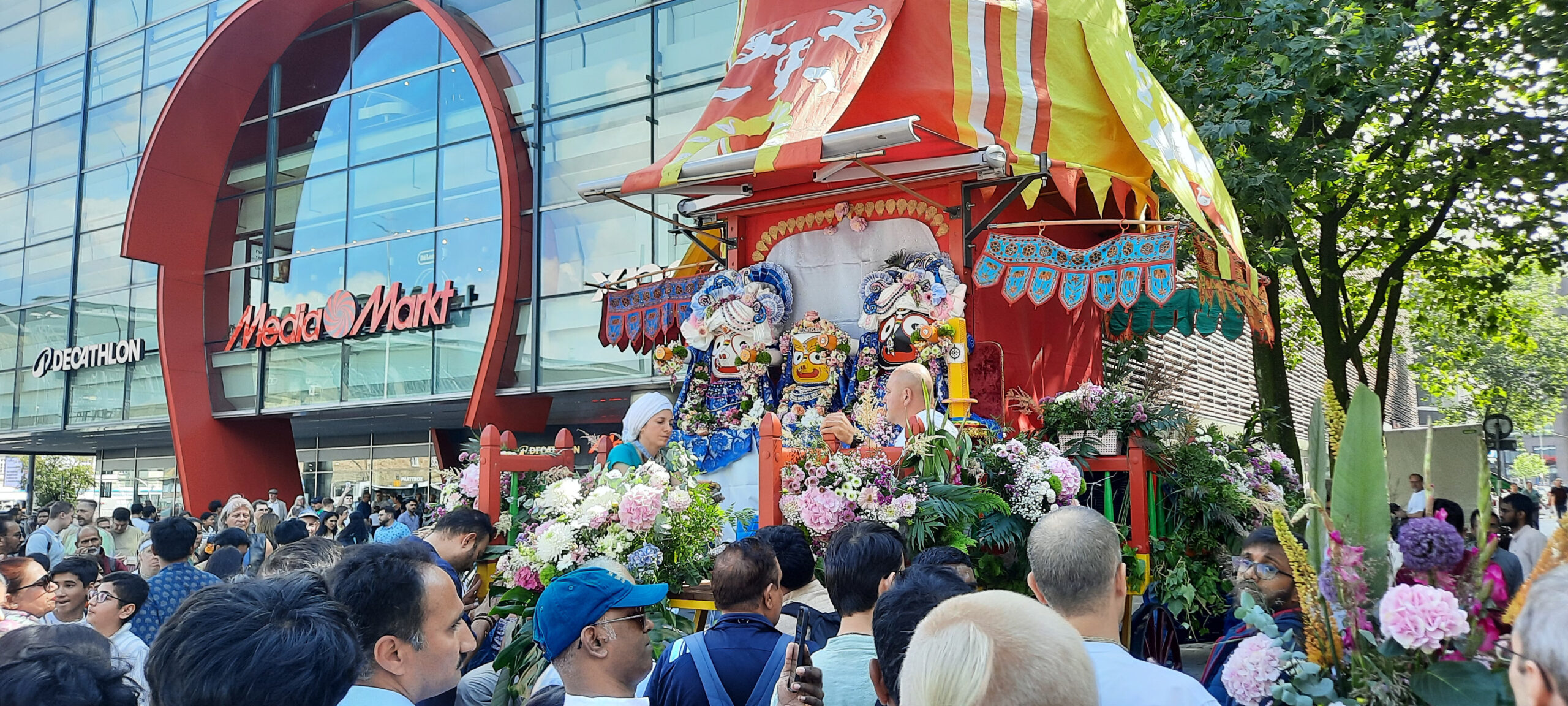
“Why are you giving the fruit away for free?”, was easily the day’s most frequently asked question, asked with that mix of suspicion and mild curiosity.
“Well, today the Lord of the Universe, Jagannatha, came out to the streets of Hamburg, and He is distributing His mercy to everyone. Every year, mostly during the summer, at least in Europe, Lord Jagannatha rides on a cart that is pulled through the busiest streets of the major cities.”
This Festival of the Chariots, is a grand event where Jagannatha, along with Baladeva and Subhadra, is brought out of the temple to give everyone an opportunity to see and worship Him. The deities are placed on a large wooden, colorfully decorated cart that is not powered by any engine, rather it is pulled by many adherents and bystanders, making it thus a community event and a symbol of unity in devotion.
For some participants, this would be a chance to directly witness and connect with God. It is an occasion where even chronic atheists or skeptics, who rely solely on sensory perception, might consider the existence of God in a tangible form. The Vedic scriptures explain that while Krishna exists in the spiritual world, which is beyond material perception, He graciously manifests Himself in material forms like wood or stone to facilitate easier connection with human beings.
It is believed that simply seeing the deities or their symbols such as the disc or flag can bring spiritual blessings and even liberation from the cycle of birth and death. The act of pulling the chariots is seen as a sacred Vedic sacrifice (yajna), wherein every step taken in service to the Lord accumulates spiritual merit. Participation is, therefore, viewed as a significant activity on the path of self-realization and spiritual development. It offers an opportunity for all, irrespective of background or beliefs, to engage in devotional activities and receive God’s blessings.
Enthusiastic devotees, led by Jaya Gaura Prabhu, pulled the brightly decorated chariot in a large loop around the part of the Hamburg’s river called Binnenalster, for nearly three hours. They sang, danced, and chanted the holy names: Hare Krishna, Hare Krishna, Krishna Krishna, Hare Hare, Hare Rama, Hare Rama, Rama Rama, Hare Hare. Senior devotees, families, children, and others joined in, creating an atmosphere of unity and devotion, all working together, distributing prasadam (mostly fruit) and Srila Prabhupada´s books. Several, equally colorful, police cars escorted the procession, ensuring everyone’s safety as the procession moved through the busy streets. Curious onlookers stopped to watch: women in headscarves, a man with dreadlocks, casual shoppers with branded bags, students, and passersby of many backgrounds. Some observed with doubt, some with joy, and some even joined the parade. Yet everyone, at least for a moment, turned their attention toward that vibrant, otherworldly spectacle moving through the streets.
But who is Jagannatha?
The legend recounts how God appeared in this unusual form. Thousands of years ago, there was a king who ardently wished to worship God on his altar. One night, Krishna appeared to him in a dream and revealed that He would manifest as a wooden log washed ashore by the sea. The king needed only to find qualified sculptors to shape the form. The following day, the king found the log and brought it to his palace. He commissioned skilled sculptors to carve the Deity, but each of their chisels inexplicably broke upon touching the wood.
Finally, an elderly sculptor took up the challenge, under the condition that he must work uninterrupted for twenty-one days behind closed doors. He warned the king that any disturbance would compel him to abandon the task. Though reluctant, the king agreed. Filled with eagerness to see the Lord, the king grew restless. Every day, he listened at the door, straining to hear the sound of the chisel. By the fourteenth day, the chiseling ceased entirely. Anxious and unable to contain himself, the king broke his promise and opened the door. To his dismay, the sculptor had vanished, leaving the forms of the Deity seemingly incomplete, without hands and legs.
The king was deeply sorrowful, realizing his impatience had ruined the unique opportunity. That night, Jagannatha appeared to him in a dream, in the very same unfinished form. He assured the king that He resides eternally in Puri, which is none other than the spiritual realm in disguise. He explained that He perpetually assumes this distinctive form. Yet, for His devoted followers, He manifests as the beautiful Krishna, adorned with a peacock feather in His hair and playing a flute with two graceful arms.
Krishna, or God, eternally exists in the spiritual realm. He is never born nor does He ever die. Krishna’s divine form resembles that of humans with two arms, two legs, a head, and a torso, but there is a significant distinction between His body and material bodies in this world.
Material bodies are composed of physical elements, making them temporary and susceptible to diseases, aging, and death. In contrast, Krishna’s body is entirely spiritual, eternal, blissful, and all-knowing. In the spiritual realm, every aspect, all the activities, situations, and all the entities are permeated with bliss, eternity, and knowledge. There is no trace of impurity as experienced in the material dimension.
Krishna holds the preeminent position in the spiritual world, and from His divine body emanate various forms which fulfill diverse functions. These forms are known as incarnations, or avataras. The incarnations are countless: Nrisimhadeva, half-man and half-lion; Matsya, the fish incarnation; Mohini Murti, the female incarnation of God; and Vamana, the dwarf incarnation, are some among the many others described in Vedic scriptures.
God, who is neither wood nor stone, manifests Himself in forms familiar to us, even though His body is transcendental and spiritual. As the creator and master of all worlds, it is entirely within His power to transform ordinary materials, such as driftwood, into representations of Himself. If God is omnipresent and the ultimate owner of everything, there is no difficulty for Him to appear in any form, including that of a piece of wood washed ashore.
However, this transformation must be authorized by Vedic scriptures and saintly persons who strictly adhere to those scriptures. Simply worshiping any random log found in the forest or creating an improvised deity will not yield spiritual benefit. The ancient texts prescribe specific methods for carving deities of Krishna, and Lord Jagannatha is explicitly described in these scriptures.
In the end, Jagannatha’s stroll through the streets of Hamburg yesterday was not only about music, colors, or festivity, it was above all about His mercy. The Lord of the Universe came out to meet the people, offering everyone an opportunity to connect with Him, even if only for a moment, simply by seeing His form. For those who chanted and helped pull His chariot, it was a step closer to self-realization, and an open invitation to remember and embrace the eternal truth of God’s love.
